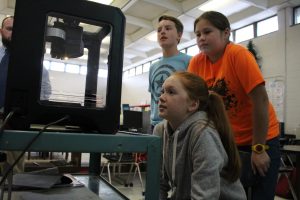 Bethel Middle School students are using their school’s 3D printer to build prosthetic hands for children in need.
Bethel Middle School students are using their school’s 3D printer to build prosthetic hands for children in need.
Last fall, BMS Media Coordinator Kendra Plemmons received a Duke Energy STEM grant through the Haywood County Schools Foundation.
She used the grant to purchase a 3D scanner to use in coordination with the school’s 3D printer.
As Plemmons researched ways to incorporate the 3D printer and scanner into her curriculum, she found the Prosthetics Kids Hand Challenge. Over the past two years, more than 800 classes from 41 different countries have worked with the organization, which was started by a middle school teacher and his students in Irmo, S.C., to build prosthetic hands for children in need.
“The Prosthetic Kids Hands Challenge allows our students the chance to collaborate, design, and print something while also changing the life of a child,” Plemmons explained. “For something to be printed, that means they have spent a great deal of time and patience designing, correcting, and printing their product.”
The STEM-based project blends science, technology, engineering, and mathematics and prepares students to be the next generation of innovators.
“STEM is so important because I not only want my students to be successful in school, but I also want to help prepare them to become productive members of society,” Plemmons said. “In order for our students to be globally competitive, we must engage them in class and encourage learning and exploration.”
Plemmons said the 3D printer and scanner have given students the opportunity to learn about new technology, from the design software, to the scanner, to the actual 3D printing process, that allows them to interact in real time while using their imagination.
“In 3D design and printing, nothing is ever perfect the first time,” Plemmons said. “The process allows students to ease their fear of failure and think critically to problem solve and gain confidence in their ability to do so.”
While in class, Plemmons functions as a facilitator while guiding students through the problem-solving process of creating the prosthetic hand. Students engage in questioning, problem solving, and collaboration while they address the design and construction of the hand.
The prosthetic hand is meant for a child who has basic wrist function but is missing fingers, Plemmons said. The wrist function allows the person to move a hinge that allows the hand to grasp. The hand is padded and attached to the forearm by Velcro straps.
Each piece of the prosthetic hand takes anywhere from four minutes to several hours to construct, and there are many pieces.
“It’s really cool that we are getting to print some kid a hand who has never even been able to pick up a cup before,” Lucas, a seventh grader said. “I like getting to design and build the different projects in class.”
The 3D printer works like a high-tech hot-glue gun Plemmons explained. Rolls of filament that come in different colors snake into the print head, where it is heated to 410 degrees Fahrenheit. The melted material comes out of a nozzle and is swirled onto the print bed. Fans then blow on the design, which make it immediately harden. Software tells the printer what coordinates to use in the design while the object grows layer by layer.
Once all pieces of the hand are printed, students will assemble the hand using everything from Velcro to fishing line. Plemmons will then ship the completed 3-D prosthetic hand to Enable the Future, where it will be inspected to ensure it functions properly, and then displayed alongside other hands created from around the world.
Once the challenge has ended, the prosthetic hands will be sent to children in need at no cost to their families.
Once the Hand Challenge has ended, Plemmons plans to incorporate the 3D printer and scanner in the media center’s Makerspace. The Makerspace is an area set up in the library that provide hands-on, creative ways to encourage students to design, experiment, build and invent. As a Makerspace fixture, the school’s 250 students will have the opportunity to design, create, and build prototypes using the 3D scanner and printer.
“I’m so thankful for the grant I received because it’s going to touch every student in our school,” Plemmons said. “My goal is to make the media center the central hub of our school and the place where students enjoy spending time reading, working, and being creative.”
